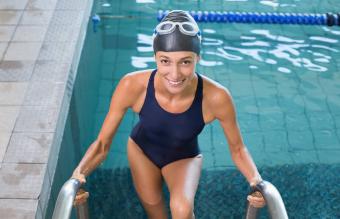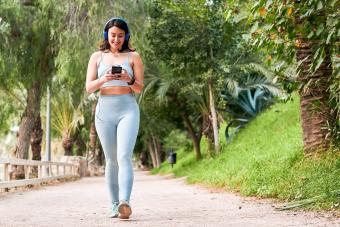
While running isn't considered a particularly expensive sport, there is no shortage of running apparel, shoes, gear, and training equipment available for purchase. If you're new to the sport, it can be overwhelming to sort through all of the choices to figure out what you need. In fact, many of the products are designed for advanced runners who participate in specialized workouts.
But there is no reason to break the bank in the early stages of your running program. Use this guide to learn how to find the best running clothes for a beginner, along with the best shoes, gear, and safety equipment.
Running Shoes for Beginners
Advanced runners often have different shoes for a variety of workouts. For instance, they might have different shoes for trail runs, track runs, long-distance runs, or simply for mid-distance runs on the road. As a beginner, it is best to invest in a multipurpose shoe that works on most terrains and supports your running style.
To find the best shoe for you, it is smart to visit a local running shoe store. Trained experts can watch you run, evaluate your gait pattern, and make a recommendation based on your footstrike. There are three footstrike patterns that they look for:
- Pronation is considered a "normal" footstrike pattern. When a pronator takes a step forward, their weight moves from the heel then forward and slightly inward through the ball of the foot. Then they push off with help from the big toe.
- Overpronation occurs when the inward motion of the footstrike is exaggerated, placing excess pressure on the arch of the foot and creating instability through the ankle. People with flat feet or low arches are often overpronators.
- Underpronation often occurs in people with high arches. When you underpronate (also called supination) you tend to exaggerate an outward roll of the foot.
Shoe companies make running shoes designed to stabilize your foot through all stages of the footstrike so that your feet, your ankles, and your hips stay healthy. If you're going to invest in only one piece of beginning running gear, shoes should be your top choice.
So how much should you expect to spend? A good pair of running shoes for a beginner can range from $75 to $150. Your running shoes can last anywhere from two months to a year depending on your mileage. Most experts say that you should replace your shoes after about 600 miles.
Running Clothes for a Beginner
When you're first starting out, you might be tempted to run in your comfy cotton sweatpants, t-shirt, or shorts. But you're likely to find that the clothes feel heavy and can chafe your skin.
You'll want to choose running wear based on the climate in which you run. But for all weather conditions, the best running outfit will be made from moisture-wicking fibers. These fabrics are designed to pull moisture away from your skin so that rubbing and chaffing do not occur. Look for synthetic fibers (such as Coolmax, nylon, or acrylic) or for synthetic blends that also have some cotton and wool.
Running Shorts
The best running shorts are usually made with lightweight fabric and are designed to allow for greater movement through the hips. They are generally shorter than traditional walking shorts and have a split side seam. Running shorts almost always have a liner so that you don't need to wear underwear (which can rub and chafe). Some running shorts also have a zip pocket on the lower back or a secure key pocket in the front.
Running Tights or Leggings
If you're running in cooler weather you'll want more coverage on your legs. Good running tights or leggings should feel snug but not tight. Again, look for moisture-wicking fabrics that provide the level of warmth that you need. If you're running in cool climates, you might opt for a ¾-length legging. But colder temperatures will require a full-length running tight that provides coverage to the ankle.
Running Socks
A good pair of running socks can help prevent blisters. Look for socks made out of synthetic fibers, wool, or a synthetic/wool blend. You might also want to buy socks with a tighter weave through the arch and fewer seams around the toe area to reduce rubbing. Lastly, beginner runners might also want to try compression socks that are (usually) made from medical-grade fabrics for added support and improved circulation in the lower leg.
Supportive Sports Bra
Activities like running that involve impact require a good sports bra. Seamless support is best so that you don't experience chafing and rubbing in the chest area. Other features to look for (especially if you are a larger busted woman) include wider straps, molded cups, and soft, sweat-resistant fabric. Whether you're trying a sports bra on in the store or at home, take a minute to jog in place to make sure that it gives you the support you need.
Running Top
Climate will determine the type of top to buy. Running in the heat? A lightweight tank is a perfect choice. Lightweight long-sleeve tops with a crew neck or v-nick are perfect for moderately cool temperatures. Look for thicker fabrics with a turtle neck for cold weather. Long-sleeve tops with a thumb hole are a great option if you want warmth on your upper hands.
Outerwear
If you run in the wind, rain, or snow, you'll need outerwear. The key here is layering. Your base layer (leggings and long-sleeve top) will keep your body warm but the outer layer protects you from the elements. Lightweight running jackets are especially useful in the spring and fall when wind and rain are likely. Look for a jacket with a hood if you plan to run in the rain or snow. In very cold weather, you might also choose to put a wind pant over your leggings.
Running Gear for Comfort and Safety
There are a few pieces of running gear that can make your experience more fun, more effective, and more safe. Consider these extras as you build your running wardrobe.
- Running belt: These lightweight belts help you carry gel packs, ID, a phone, and other essentials. There are different styles available. Look for one that doesn't move too much as you step forward.
- Running watch: While pricey, a good sports watch can provide you with data about distance, pace, and even elevation on your run. Some even display text messages and play music.
- Sports sunglasses: The best sunglasses for a runner will have a rubber nose-grip so that the glasses don't slide down your nose when you sweat. Look for a pair that wrap around your face slightly to protect your eyes from wind and sun.
- Running hat: Many brands make very lightweight hats that provide a visor to protect your eyes and face, but also provide plenty of ventilation so your head doesn't overheat.
- ID bracelet: If you don't carry a phone (and especially if you run alone) you'll want an ID bracelet to wear on your wrist or ankle. In the unlikely event of an accident, the band can help emergency personnel contact loved ones or provide information to medical workers about your health.
- Lightweight earbuds: If you listen to music when you run, you'll want lightweight earbuds that stay secure in your ears even when your body is bouncing up and down. In addition to a secure fit, you might also want to look for a pair that uses a Bluetooth connection so you don't have to worry about cords
- Personal protection: If you run alone, if you run in the dark, or if you run in areas that are unfamiliar to you, it is smart to carry some form of personal protective device. Some women carry a whistle, while others carry self-defense sprays or other devices. Laws regarding protective devices vary from state to state, so be sure that whatever you carry meets local guidelines.
The Best Running Outfit For You
If you're concerned about budget, don't worry. You don't need everything on this list when you're a beginner runner. But it can be helpful to explore your options as you shop for running gear.
Start with the basics: good shoes, good socks, and a supportive bra. Then build on your running wardrobe by adding shorts, leggings, and tights. Finally, add gear such as a watch or sunglasses. As you build your running program and add mileage to your workouts you'll find out what works best for you so that you stay strong and motivated to reach your running goals.







